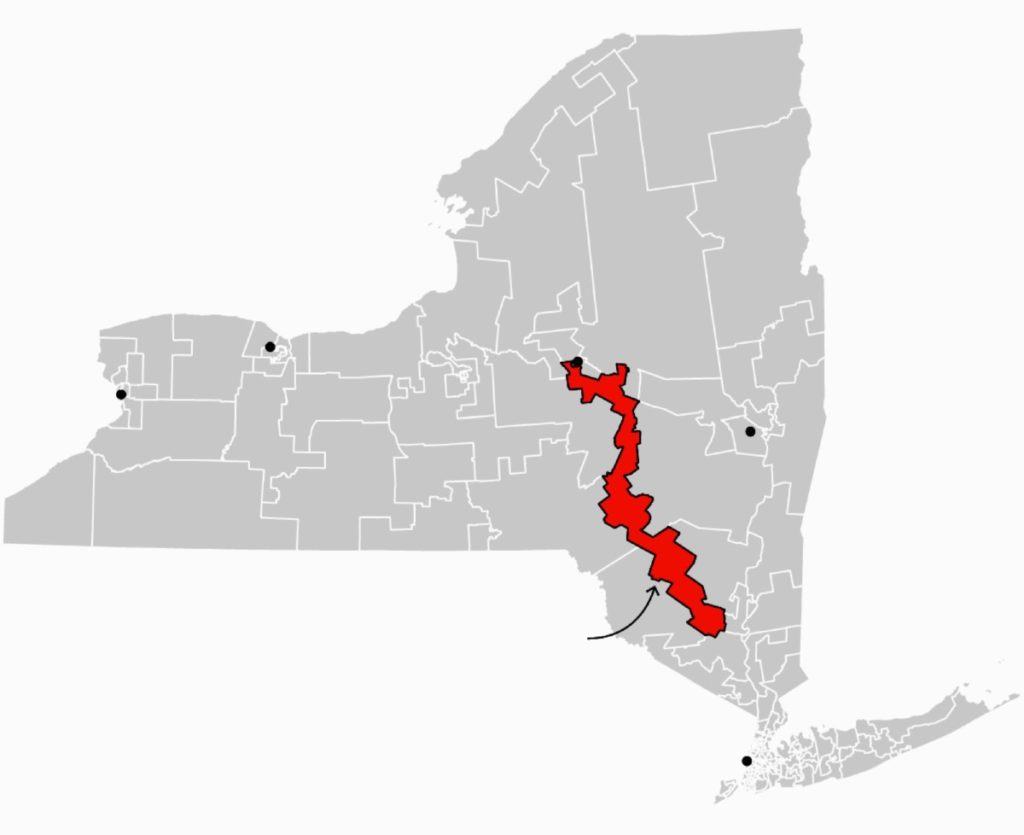Column by Adrian Kuzminski for November 2, 2018
Gerrymandering Takes Away
Our Right To Representation

The most remarkable thing I’ve seen in this year’s midterm
election campaigns is Chad McEvoy’s op-ed in the New York Times. The headline says it all: “If I win my district, I’ll get rid of it.”
That’s the 101st Assembly District, a model of gerrymandering, which snakes in a narrow strip from New Hartford near Utica through part of Otsego county to the Hudson Valley.
Its shape guarantees that almost nobody living in the district is connected to anyone else in it. Its only purpose is to provide a safe seat for a politician who can be sure that his atomized constituents have no voice of their own.
Chad is running to overturn this kind of all too familiar nonsense.
The 101st district is an egregious case of gerrymandering, but in fact most of our legislative districts work exactly the same way. Most people couldn’t find their state legislative or Congressional districts on a map, or even name them accurately.
The districts overlay and cut across one another in insane fashion. People in one Congressional district are guaranteed not to be together in the same state Assembly or Senate districts.
Divide and conquer is obviously the rule.
Most districts are spread over a large number of communities almost entirely unique in terms of jobs, industry, schools, social services, and so on. That means our local communities are NOT represented in Albany or Washington.
The heart of your community is where you live and work. It includes your neighborhood, the town where you do most of your business and shopping, and the school district where your kids go. For most people – except for those commuting to distant jobs (say 20 miles or more) – these functions mostly overlap.
Call it home.
The largest local unit which people recognize and more or less identify with is the county, which administers social services, collects taxes, provides public safety, manages code enforcement and waste disposal, maintains major local highways, carries out environmental and planning responsibilities, and coordinates local towns which enjoy home rules under the state Constitution.
People know their counties; counties are the largest political entities which still function as communities. The county should be the political district that is directly represented in Albany, if not in Washington.
New York has 62 counties and representatives elected from each of those counties could comprise at least the state Assembly, if not the entire state legislature. That would be one way to upset business-as-usual in Albany and put the public back
in control.

Of course, counties differ widely in size. The largest county in the state – King’s County(Brooklyn)– has a population of 2,504,700, while the smallest – Hamilton County, in the Adirondacks – has 4,836 residents. But just as towns are represented on the Otsego county Board of Representatives by weighted voting, counties could be represented in Albany the same way.
The larger number of smaller, more rural counties would naturally work together to offset the clout of the fewer number of larger counties.
As far as Congressional districts go, in densely populated areas (like New York City) they should be drawn to be within counties as much as possible. In less dense areas, like Upstate, they can be drawn to include whole counties as closely as they can.
The point is that the interests of, say, Otsego county, would have a direct voice in Albany, something that is NOT currently the case.
In fact, our communities
are not directly represented anywhere at all.
This lack of representation
goes a long way towards explaining why a place like Otsego county has long suffered chronic economic decline and social malaise.
Let me close with a couple of personal endorsements of local candidates who recognize the need for the kind of fundamental change I’m talking about.
One is Chad McEvoy in the 101st Assembly District, as discussed above. Chad wants to strengthen local education, supports single-payer health care for New Yorkers, and advocates universal broadband and green energy as economic drivers.
The other candidate I’m voting for is Joyce St. George in the 51st Senate district. St. George – a feisty, anti-corruption investigator and local business woman who also supports single-payer health for all New Yorkers – is running against our long-time senator Jim Seward, who represents the status quo.
Seward has made a career of recycling taxpayers’ own dollars back to them as perks for which he can take credit; his so-called “economic summits” have gone nowhere; and his environmental record is among the worst in Albany – he’s been consistently rated near the bottom of New York legislators by the watchdog group Environmental Advocates. If you think we can do better on these issues, vote for St. George.
Adrian Kuzminski, a retired Hartwick College philosophy professor
and Sustainable Otsego
moderator, lives in Fly Creek.

